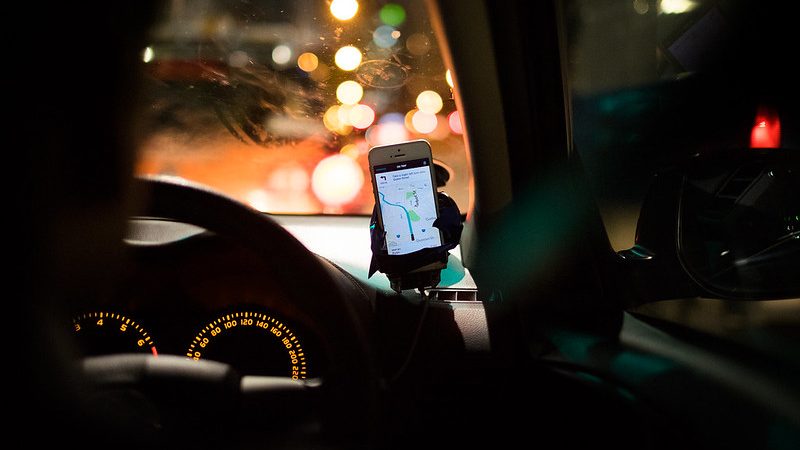Drivers report being 'terminated' through 'no reply' emails, and unable to challenge dismissals, in a worrying development for workers.

Andrew Kersley is a freelance journalist.
Over the last fortnight Deliveroo has been on a charm offensive, ahead of its initial public offering – or IPO – on the London stock exchange. With a potential £10bn valuation on the table it shouldn’t be too surprising that Deliveroo is fighting to win over public opinion.
But behind the scenes gig economy giants like Deliveroo, Ola and UberEats are increasingly relying on automation and flawed algorithms to cut costs that activists say is having a disastrous outcome for workers. I recently finished an investigation into UberEats’ use of facial identification software.
We documented 14 cases of the software, which had a proven record of failing on darker skinned faces, misidentifying the faces of non-white workers leading to them being fired or threatened with being fired for ‘illegal shift substitution’. Faced with the Kafkaesque accusation of not being themselves, the workers said they were unable to even contact Uber to protest and simply received automated dismissal messages. Two tried contacting UberEats through their local Labour MPs only to receive almost entirely copy-pasted responses.
In that case, Uber claimed that the system always had human oversight and the chance to appeal. It’s just one of various problems I’ve been told about by trade unions representing gig economy workers, from drivers facing automated ‘robo-firings’ to fraud algorithms redirecting work away from drivers deemed to be unreliable.
Working in the gig economy seemed like a dream for Omar* when he arrived in London – a way to flexibly make money before starting his own business. Five years on, he was fired after failing UberEats facial identification software. He says the selfie function in his app wasn’t working and he was forced to take a picture on a second phone.
“Straight away I received a message saying the app has been shut down. And after that, I wasn’t able to talk to anyone from Uber,” he recalled. Even the dismissal email he received came from a ‘no-reply’ address.
Now without work, Omar is struggling to pay the bills. “They should have done an investigation. They aren’t judge, jury and executioner,” he told me. “You get fired in one click. It’s just a click. They don’t know if the rider has responsibilities, has a family. You are just a number to them.”
If the impact on his income wasn’t enough, Omar is now being refused Universal Credit. He says that despite being employed for half a decade UberEats and Deliveroo keep so few records that he is struggling to prove he has actually been employed in England for the last five years.
Uber stresses that they take deactivation decisions “very seriously”, have “robust” processes to deal with cases like Omar’s and say they are always contactable if drivers have any concerns. In a court ruling in Amsterdam last week, judges ruled that the systems used by Uber had meaningful human oversight, but ordered the company to disclose the basis the evidence behind its allegations of unspecified ‘fraudulent activity’ made against two drivers that led to their dismissals.
The conventional way we imagine automation is as a way to replace the workforce itself – the classic example being the self-checkout in a supermarket slowly replacing checkout workers. And as the technology becomes increasingly cheaper year on year, it’s used as a perverse justification to lower workers’ pay and conditions to keep them ‘competitive’ with machines.
But what’s different about the kind of automation in the gig economy is that it’s used to cut the costs of employment. The actual main labour force is human but the company infrastructure that handles everything from hiring and firing to human resources is increasingly automated. As another driver who was almost fired after being misidentified during an ID check put it: “I don’t know if you’ve ever tried to get in contact with Uber, but they don’t employ human beings”.
It makes financial sense – as these new companies scale-up, they don’t have to spend vastly increasing amounts on backroom management, organisation and infrastructure. But while there is a reduced cost on their balance sheet, an untold human cost can end up being paid by their workforce.
One union official described to me how delivery drivers now live in fear of customers filing complaints about missing food. Whether the complaint is true or if it was the restaurant that made the mistake is rarely investigated I’m told, and frequently drivers face being dismissed over the allegation. Firing disposable workers is said to be cheaper than checking if they ever did anything wrong.
And for gig economy workers, who have far less legal protections than others, the problem is all the more acute as campaigners say there is little to no framework for them to take cases to tribunal. As low-paid workers, disproportionately from non-white backgrounds, gig economy workers are already one of the most marginalised parts of society, despite accounting for almost five million people as of 2019.
If nothing is done to protect their rights, then we risk normalising a society with little to no protections for a huge chunk of the workforce – a society where minorities can be fired just because an algorithm struggles to recognise the colour of their skin.
*Names have been changed.
Image credit: Noel Tock (CC).
To reach hundreds of thousands of new readers we need to grow our donor base substantially.
That's why in 2024, we are seeking to generate 150 additional regular donors to support Left Foot Forward's work.
We still need another 117 people to donate to hit the target. You can help. Donate today.



